7/3/1863 - For a third day, the Battle of Gettysburg between Confederate General Robert E. Lee's Army of Northern Virginia (estimated at 75,000 soldiers strong) and newly appointed Union Major General George B. Meade's Army of the Potomac (104,256 men "present for duty") rages on among the hills and farmlands of Adams County, Pennsylvania. The largest battle thus far to ever be fought on the North American continent, the first two days of combat feature back-and-forth blood letting at sites now famous in American history ... Herr Ridge, McPherson Ridge, Seminary Ridge, Willoughby Run, McPherson Woods, the Railroad Cut, the Chambersburg Pike, Cemetery Hill, Cemetery Ridge, Barlow's Knoll, Culp's Hill, the Peach Orchard, Round Top, Little Round Top, the Devil's Den, Plum Run Valley, the Slaughter Pen, and the Wheatfield. Almost victorious on a number of occasions attacking the flanks of the Union line, on the third day of battle Lee resolves to hit what he believes is Meade's weakened center ... setting in motion the largest artillery bombardment of the war (at 1:00 in the afternoon, between 150 to 170 Confederate guns open up on the Northern line) and what comes to be known as Pickett's Charge ... an assault by roughly 13,000 Southerners under the command of Major General George Pickett.
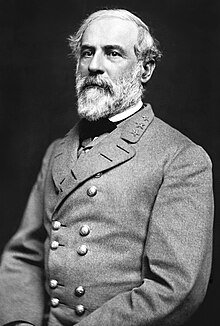
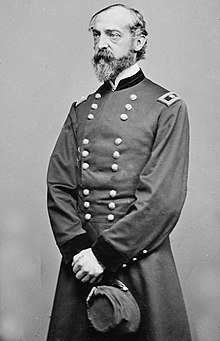
Lee & Meade
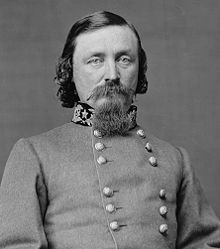
Pickett

Reynolds Arrives - Day 1
Chamberlain's Bayonet Charge Down Little Round Top - Day 2
Stories of bravery and cowardice abundant on both sides, at the very epicenter of the charge is Battery "A" of the 4th U.S. Light Artillery, a part of the Army of the Potomac's II Corps, under the command of "Hancock the Superb" (at Gettysburg the moniker is certainly deserved ... on the first day of the battle it is Hancock that steadies retreating Northern troops and organizes them into the "fish hook" defensive line that has become famous, on the second day it is Hancock that sends various units to shore up breaches in the line that threaten destruction of the army, and on day three, it is Hancock's Corps that is charged by Pickett, with the general leading from the front, staying with his men until the battle is over despite being grievously wounded in the right thigh), Major General Winfield Scott Hancock. Originally created to be part of the defenses of Washington D.C., in March of 1862 the unit becomes part North's biggest army and participates in the siege of Yorktown, the Battle of Seven Pines, the Battle of Fair Oaks, the Battle of Savage Station, the Battle of White Oak Swamp, the Battle of Malvern Hill, the Battle of Antietam, the Battle of Fredericksburg, and the Battle of Chancellorsville. One-hundred-twenty-six men (other sources have the unit's strength at 82-men and 110-men), ninety horses, and six three-inch rifles, by the summer of 1863, the unit is under the command of 22-year-old Brevet Major Alonzo Hersford Cushing of Delafield, Wisconsin.
Hancock
Three-Inch Rifle
The youngest of four boys (not the only soldier Cushing, one brother will receive a "Thanks of Congress" for his contributions to the sinking of the Confederate ironclad, CSS Albermarle, and another will become known as the "Custer of Arizona" for his clashes with Apache Indians) born to Milton Buckingham Cushing and Mary B. Cushing, Alonzo begins his life on 1/19/1841 in Delafield, Wisconsin, but on the death of his father in 1847, moves with his family to Fredonia, New York. Growing into a young adult, Cushing is appointed to West Point in 1857 (recommended by Congressman Francis Smith Edwards) and becomes a part of the legendary 34-man class of 1861, graduating 12th in a group that includes one of the saviors of Little Round Top, #1 student Patrick O'Rorke, and the worst student of the group, a horseback rider of extraordinary ability from Monroe, Michigan named George Armstrong Custer. Commissioned a first lieutenant upon graduation, Cushing serves as an Ordinance Officer and then Aide-de-Camp to Major General Edwin V. Sumner, acts as an Assistant Topographical Engineer, and sees action at the First Battle of Manassas (or Bull Run if you prefer), the Battle of Antietam, and at the Battle of Fredericksburg and the Battle of Chancellorsville, is cited for "gallant and meritorious services."
West Point
Lieutenant
At Gettysburg, Cushing and Battery "A" spend the first day of battle marching from north to the crossroads town. Arriving, they are assigned a position by a fence and stone wall in the center of the Union line on Cemetery Ridge, near a small copse of trees ... a location that will go down in history as "The Angle." A quiet part of the field on day two as Lee hits Culp's Hill and the Little Round Top area on the flanks of the Army of the Potomac, the battery sees little action until the third day of fighting in Adams County, but then gets enough to last an eternity.
Setting Up
A quiet morning, the soldiers of Hancock's II Corps are just settling in to a midday meal when the artillery of Lt. General James Longstreet's First Corps, commanded by Colonel Edward Porter Alexander, opens up on the center of the Union line. Meant to isolate the section of Union line about to be attacked, knock out guns that could stop the Confederate charge, and demoralize the Northern soldiers that are going to be assaulted, between 150 to 170 cannons, firing in a line over two miles long, pitch shells at the troops of Hancock (the general spends the time riding along his line, refusing to take cover, stating, "There are times when a corps commader's life does not count.") for over an hour in the largest battle bombardment of the war ... which fails. Smoke covering targets, the guns of Lee's other two Corps not contributing, defective fuses, a lack of ammo, and the duping of the Confederates by the North slowly stopping return fire so as to appear to have had their guns put out of action (a successful ploy by Union artillery chief, Brigadier General Henry J. Hunt) all contribute to the Army of the Potomac's guns still be ready for the charge they know is now coming their way.
Afternoon Cannonade
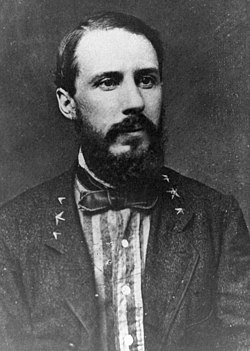
Alexander
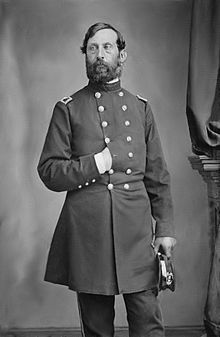
Hunt
While the goal of silencing the Union's guns is not successful, parts of the northern line are hammered, including Cushing's. By around 2:00 when Pickett's men start forward in their fatal advance to the high tide line of the Confederacy, Cushing is down to only two guns (by battle's end, 83 of the 90 horses the unit uses for transportation have been killed, 9 ammo chests have been blown up, none of the unit's transportation has a whole wheel, every officer has either been killed or wounded, and the enlisted men suffer a casualty rate of 60%. And among the wounded, is Cushing.
Cushing
Directing his unit's counter fire, Cushing takes his first hit of the day when a shell fragment from a Confederate gun hits the young officer in the right shoulder. Refusing to leave to receive medical treatment, he pulls his pistol and keeps his command from fleeing the field by threatening to "...blow out the brains ..." of anyone he finds attempting to desert, and when Pickett's Charge begins, Cushing is with the last two guns of his unit ... there he takes his second injury of the day when shrapnel rips open both his thighs in the private parts region and stomach. In extreme pain and a bloody mess, to the extent that he has to prevent his mangled intestines from falling to the ground by holding them in with his hand, Cushing again refuses to leave his command (stating he will "... fight it out, or die in the attempt."), and is supported in his effort to keep his guns firing by 27-year-old First Sergeant Frederick Fuger of Goppingen, Germany, who holds the wounded officer up so he can keep searching out targets, and when blood weakened too badly to keep yelling out orders, relay's Cushing's commands to the remaining men of the unit (for his actions with Battery "A," Fuger will be awarded a Congressional Medal of Honor) with shouts of his own.

Battery "A" In Action

Fuger

Gettysburg Diorama Detal - Center - Fuger Holding The Wounded Cushing
Canister instead of shell as the Southern charge moves to within 100 yards of Cushing's guns, the young officer says to Fuger, "That's excellent. Keep that range!" when he takes his third and final injury of the day as a Confederate bullet enters his open mouth and then blows out the back of Cushing's head. Killed instantly by the round, Cushing is lowered to the ground and Fuger takes over total command of the unit, firing a last canister round just as the Southerners, led by Brigadier General Lewis Armistead (who will be mortally wounded seconds later), about 2,500 strong, arrive at the battery's position. Last working guns captured as what is left of the unit finally falls back, the weapons are turned around to be fired at Union troops, but can't be used because the battery has used up ever piece of ordinance it had in its arsenal ... and brief seconds later it doesn't matter anyway as reinforcements from Brigadier General Alexander S. Webb arrive on the scene (personally led forward by Webb, who is wounded in the thigh and groin, but lives to receive a Congressional Medal of Honor) and beat back the Southerners, ending Pickett's Charge.

Last Shot
Armistead At Cushing's Guns

Lee Recognizing His Defeat
Decisive victory won by the North, Cushing's exploits are noted in every telling of Pickett's Charge, but go unrewarded at first except for his posthumous brevet promotion to lieutenant colonel ... the newly anointed award of a Congressional Medal is only given to living soldiers. A wrong needing righting as the standards of the award change over time, in 1987, Wisconsin resident Margaret Zerwekh (who lives in Delafield on a property once owned by Cushing's father and is the granddaughter of a Union veteran) begins a writing campaign to Congress to get Cushing the Medal of Honor he deserves (the first post goes to Senator William Proxmire). Long ago not a priority apparently, letters are sent to Congress for years, until finally, Wisconsin Congressman Ron Kind and Wisconsin Senator Russ Feingold throw their backing to the project. Approved by the U.S. Army, in May of 2010, Congress announces a posthumous Congressional Medal of Honor will be awarded to Cushing. But there is one last hurdle to clear ... approval attached to a defense spending bill, the provision awarding Cushing the medal is removed from the bill by Senator Jim Webb of Virginia in 2012. New bill for army bucks cobbled together, Cushing gets another chance to be officially acknowledged a hero in 2013 ... and the deed is finally done when President Obama signs the bill, and then in a White House ceremony (which the 94-year-old Zerwekh attends), awards a posthumous Congressional Medal of Honor in the name of Alonzo Cushing to two dozen members of the Cushing Family (not in attendance but proof that the warrior in the blood of the Cushing's still runs strong, USC All-American and All-Pro Houston Texan linebacker is a distant relative of the Battery "A" commander) ... 147 years after Cushing's death at Gettysburg, the longest wait between deed and award in the history of the medal.
Zerwekh
Distant Cousin Helen Loring Ensign And President Obama

Brian Cushing
A hero now for as long as there is a United States of America, Alonzo Cushing rests in the post cemetery at his West Point Alma mater, in Section 26, Row A, Grave 7, beside the grave of fellow Gettysburg hero, Major General John Buford, Jr., the cavalry commander who starts the battle by refusing to allow Henry Heth's men shoe access into Gettysburg. Upon Cushing's tombstone is the inscription, "Faithful unto Death." Indeed ... and amen!
Gettysburg Battlefield - Monument To Battery "A"
Gettysburg Battlefield - Alonzo Cushing Memorial
Monument - Cushing Memorial Park - Wisconsin

Cushing Tombstone
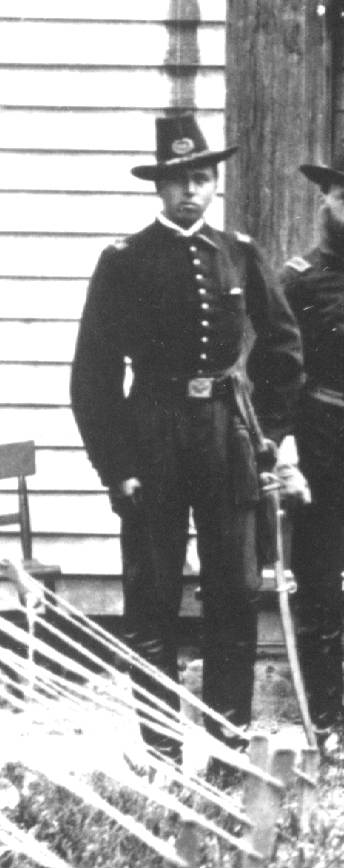
Alonzo Hersford Cushing